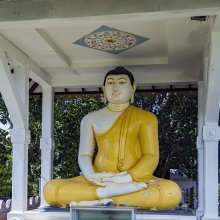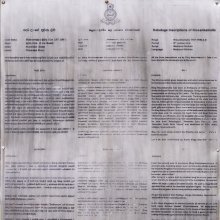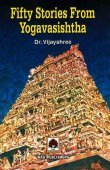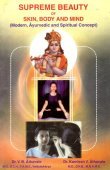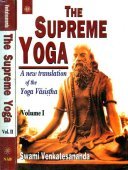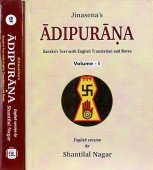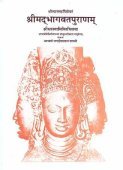Tama, Tāma, Tāmā: 25 definitions
Introduction:
Tama means something in Buddhism, Pali, Hinduism, Sanskrit, Jainism, Prakrit, Marathi, Hindi, biology, Tamil. If you want to know the exact meaning, history, etymology or English translation of this term then check out the descriptions on this page. Add your comment or reference to a book if you want to contribute to this summary article.
Images (photo gallery)
In Hinduism
Purana and Itihasa (epic history)
Source: archive.org: Puranic EncyclopediaTama (तम).—A King who was the son of Śravā of the race of King Gṛtsamada. (Śloka 63, Chapter 30, Anuśāsana Parva).
Source: Cologne Digital Sanskrit Dictionaries: The Purana Index1a) Tama (तम).—(lokapṛṣṭha): a kind of hell: persons fallen from varṇa and āśramadharma find this hell.*
- * Brahmāṇḍa-purāṇa IV. 2. 150, 177-78; Vāyu-purāṇa 101. 149, 179; Viṣṇu-purāṇa II. 6. 4.
1b) Equated with ajñāna or ignorance, bound by three fetters; to think that which is not eternal as eternal, to regard happiness in one's difficulties, to regard one's own self which is not his own, and to regard that as pure which is impure;1 fourfold, with Tāmasi vṛtti, the lowest.2
1c) The eleventh kalpa.*
- * Matsya-purāṇa 290. 5.

The Purana (पुराण, purāṇas) refers to Sanskrit literature preserving ancient India’s vast cultural history, including historical legends, religious ceremonies, various arts and sciences. The eighteen mahapuranas total over 400,000 shlokas (metrical couplets) and date to at least several centuries BCE.
Vyakarana (Sanskrit grammar)
Source: Wikisource: A dictionary of Sanskrit grammarTama (तम).—Common term for the tad. affixes तमट् (tamaṭ) and तमप् (tamap).
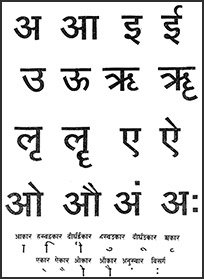
Vyakarana (व्याकरण, vyākaraṇa) refers to Sanskrit grammar and represents one of the six additional sciences (vedanga) to be studied along with the Vedas. Vyakarana concerns itself with the rules of Sanskrit grammar and linguistic analysis in order to establish the correct context of words and sentences.
Ayurveda (science of life)
Source: gurumukhi.ru: Ayurveda glossary of termsTama (तम):—1. One of the three qualities (Sattva, Rajas and Tamas) or constituents of everything in creation. 2. Ignorance, illusion, lust 3. Darkness

Āyurveda (आयुर्वेद, ayurveda) is a branch of Indian science dealing with medicine, herbalism, taxology, anatomy, surgery, alchemy and related topics. Traditional practice of Āyurveda in ancient India dates back to at least the first millenium BC. Literature is commonly written in Sanskrit using various poetic metres.
In Buddhism
Tibetan Buddhism (Vajrayana or tantric Buddhism)
Source: Wisdom Library: Tibetan BuddhismTama (तम) is the name of a Rāśi (zodiac sign) mentioned as attending the teachings in the 6th century Mañjuśrīmūlakalpa: one of the largest Kriyā Tantras devoted to Mañjuśrī (the Bodhisattva of wisdom) representing an encyclopedia of knowledge primarily concerned with ritualistic elements in Buddhism. The teachings in this text originate from Mañjuśrī and were taught to and by Buddha Śākyamuni in the presence of a large audience (including Tama).

Tibetan Buddhism includes schools such as Nyingma, Kadampa, Kagyu and Gelug. Their primary canon of literature is divided in two broad categories: The Kangyur, which consists of Buddha’s words, and the Tengyur, which includes commentaries from various sources. Esotericism and tantra techniques (vajrayāna) are collected indepently.
In Jainism
General definition (in Jainism)
Source: archive.org: Een Kritische Studie Van Svayambhūdeva’s PaümacariuTama (तम) participated in the war between Rāma and Rāvaṇa, on the side of the latter, as mentioned in Svayambhūdeva’s Paumacariu (Padmacarita, Paumacariya or Rāmāyaṇapurāṇa) chapter 57ff. Svayambhū or Svayambhūdeva (8th or 9th century) was a Jain householder who probably lived in Karnataka. His work recounts the popular Rāma story as known from the older work Rāmāyaṇa (written by Vālmīki). Various chapters [mentioning Tama] are dedicated to the humongous battle whose armies (known as akṣauhiṇīs) consisted of millions of soldiers, horses and elephants, etc.

Jainism is an Indian religion of Dharma whose doctrine revolves around harmlessness (ahimsa) towards every living being. The two major branches (Digambara and Svetambara) of Jainism stimulate self-control (or, shramana, ‘self-reliance’) and spiritual development through a path of peace for the soul to progess to the ultimate goal.
Biology (plants and animals)
Source: Google Books: CRC World Dictionary (Regional names)1) Tama in India is the name of a plant defined with Dendrocalamus hamiltonii in various botanical sources. This page contains potential references in Ayurveda, modern medicine, and other folk traditions or local practices.
2) Tama is also identified with Garcinia morella It has the synonym Garcinia morella (Gaertn.) Desr. (etc.).
3) Tama is also identified with Potentilla argyrophylla It has the synonym Potentilla argyrophylla Wall..
Example references for further research on medicinal uses or toxicity (see latin names for full list):
· Musée botanique de M. Benjamin Delessert. (1845)
· The European Discovery of the Indian Flora. (1992)
· Memoir and Correspondence of … Sir J.E. Smith (1832)
· Flora of the British India (1878)
· A Numerical List of dried specimens of plants in the East India Company's Museum
· Encyclopédie Méthodique, Botanique (1783)
If you are looking for specific details regarding Tama, for example chemical composition, extract dosage, health benefits, side effects, diet and recipes, pregnancy safety, have a look at these references.

This sections includes definitions from the five kingdoms of living things: Animals, Plants, Fungi, Protists and Monera. It will include both the official binomial nomenclature (scientific names usually in Latin) as well as regional spellings and variants.
Languages of India and abroad
Pali-English dictionary
Source: BuddhaSasana: Concise Pali-English Dictionarytama : (m.; nt.) (mano-group), darkness, ignorance. (in cpds. it becomes tamo.)
Source: Sutta: The Pali Text Society's Pali-English DictionaryTama, (nt.) & tamo (Sk. tamas, tam & tim, cp. tamisra= Lat. tenebræ; also timira dark & P. tibba, timira; Ohg. dinstar & finstar; Ags. thimm, E. dim) darkness (syn. andhakāra, opp. joti), lit. as well as fig. (mental darkness=ignorance or state of doubt); one of the dark states of life & rebirth; adj. living in one of the dark spheres of life (cp. kaṇhajāta) or in a state of suffering (duggati) Sn. 248 (pecca tamaṃ vajanti ye patanti sattā nirayaṃ avaṃsirā), 763 (nivutānaṃ t. hoti andhakāro apassataṃ), 956 (sabbaṃ tamaṃ vinodetvā); Vbh. 367 (three tamāni: in past, present & future). adj. : puggalo tamo tama-parāyaṇo D. III, 233; A. II, 85= Pug. 51; J. II, 17.—tamā tamaṃ out of one “duggati” into another Sn. 278 (vinipātaṃ samāpanno gabbhā gabbhaṃ t. t... . dukkaṃ nigacchati), cp. M Vastu II. 225, also tamāto tamaṃ ibid. I. 27; II, 215.—tamat.—agge beyond the region of darkness (or rebirth in dark spheres), cp. bhavagge (& Sk. tamaḥ pāre) S. V, 154, 163.
— or —
Tāma, (Sk. tāma) desire, longing, greed in tāmatamadasaṅgha-suppahīna Th. 1, 310, an epithet of frogs, which perhaps (with Kern, Toev. II. 88) is to be read as tāma-tamata-suppahita; “horribly greedy” (Kern, gruwelijk vraatzuchtig). (Page 299)

Pali is the language of the Tipiṭaka, which is the sacred canon of Theravāda Buddhism and contains much of the Buddha’s speech. Closeley related to Sanskrit, both languages are used interchangeably between religions.
Marathi-English dictionary
Source: DDSA: The Molesworth Marathi and English Dictionarytama (तम).—m n (S) Darkness. 2 The third of the qualities incident to created being, the tamaguṇa or property of darkness; whence proceed folly, ignorance, worldly delusion, the blindness of lust, anger, pride. 3 m Vaporing, blustering, roistering, angry or proud swelling. v gā, kara, māṇḍa.
--- OR ---
tama (तम).—ind An adjunct to Sanskrit adjectives, denoting the superlative degree. Ex. duṣṭa, duṣṭatara, duṣṭatama Bad, worse, worst.
--- OR ---
tamā (तमा).—f ( A Lust, desire.) Care or fear respecting; awe of; regard or consideration for as great. Neg. con.
--- OR ---
tāma (ताम).—& tāmarā See tāmba & tāmbarā.
Source: DDSA: The Aryabhusan school dictionary, Marathi-Englishtama (तम).—m n Darkness, ignorance. m Vapouring.
--- OR ---
tamā (तमा).—f Awe of; regard for as great.
Marathi is an Indo-European language having over 70 million native speakers people in (predominantly) Maharashtra India. Marathi, like many other Indo-Aryan languages, evolved from early forms of Prakrit, which itself is a subset of Sanskrit, one of the most ancient languages of the world.
Sanskrit dictionary
Source: DDSA: The practical Sanskrit-English dictionaryTama (तम).—Darkness.
2) The tip of the foot.
-maḥ 1 An epithet of Rāhu.
2) The Tamāla tree.
3) Darkness.
Derivable forms: tamam (तमम्).
--- OR ---
Tamā (तमा).—A night.
See also (synonyms): tamasvinī.
--- OR ---
Tama (तम).—A Taddhita affix of the superlative degree applied to nouns, adjectives and also to verbs and indeclinables in which latter case it is changed to तमाम् (tamām); अश्व° (aśva°) Pañcatantra (Bombay) 5. 'the best horse'; सुहृत्तम (suhṛttama) Mu.I; so पचतितमाम् (pacatitamām). It is also added to pronouns in the sense of 'one of many' e. g. कतम, यतम, ततम (katama, yatama, tatama) &c.
--- OR ---
Tāma (ताम).—[tam-karaṇe ghañ]
1) An object of terror.
2) A fault, defect.
3) Anxiety, distress.
4) Desire.
5) Exhaustion, fatigue.
Derivable forms: tāmaḥ (तामः).
Source: Cologne Digital Sanskrit Dictionaries: Shabda-Sagara Sanskrit-English DictionaryTama (तम).—m.
(-maḥ) The quality of darkness incident to humanity: see tamas. mf.
(-maḥ-mā) A tree bearing black blossoms. n.
(-maṃ) 1. Darkness, gloom. 2. The point of the foot. f. (-mā-mī) Night. E. tam to be disturbed, to be fatigued, &c. affixes karaṇe ghañarthe saṃjñāyāṃ gha, and ṭāp or ṅīṣ.
--- OR ---
Tāma (ताम).—m.
(-maḥ) An object of terror. 2. Fault, defect, vice. 3. Anxiety, distress. 4. Desire. E. tam to be distressed, affix karaṇe bhāve vā ghañ .
Source: Cologne Digital Sanskrit Dictionaries: Benfey Sanskrit-English DictionaryTama (तम).—tama = iṣṭatama in [Kirātārjunīya] 2, 13.
Source: Cologne Digital Sanskrit Dictionaries: Cappeller Sanskrit-English DictionaryTāma (ताम).—[masculine] longing, desire.
Source: Cologne Digital Sanskrit Dictionaries: Monier-Williams Sanskrit-English Dictionary1) Tama (तम):—[from tam] 1. tama m. ([Pāṇini 7-3, 34; Kāśikā-vṛtti]) = tamas (‘the ascending node’ [Varāha-mihira’s Bṛhajjātaka] [?] [Jyotiṣa]), [cf. Lexicographers, esp. such as amarasiṃha, halāyudha, hemacandra, etc. [Scholiast or Commentator]]
2) [v.s. ...] (= māla) Xanthochymus pictorius, [cf. Lexicographers, esp. such as amarasiṃha, halāyudha, hemacandra, etc.]
3) [v.s. ...] = makā, [cf. Lexicographers, esp. such as amarasiṃha, halāyudha, hemacandra, etc.]
4) [v.s. ...] n. (= mas) darkness, [cf. Lexicographers, esp. such as amarasiṃha, halāyudha, hemacandra, etc.]
5) [v.s. ...] the point of the foot, [cf. Lexicographers, esp. such as amarasiṃha, halāyudha, hemacandra, etc.]
6) Tamā (तमा):—[from tama > tam] f. night, [cf. Lexicographers, esp. such as amarasiṃha, halāyudha, hemacandra, etc.]
7) [v.s. ...] Xanthochymus pictorius, [cf. Lexicographers, esp. such as amarasiṃha, halāyudha, hemacandra, etc.]
8) Tama (तम):—2. tama an affix forming the [superlative degree] degree of adjectives and rarely of substantives (kaṇva-, etc.), [Suśruta i, 20, 11]
9) mfn. most desired, [Kirātārjunīya, ii, 14]
10) Tāma (ताम):—m. (√tam) = bhīṣaṇa, [cf. Lexicographers, esp. such as amarasiṃha, halāyudha, hemacandra, etc.]
11) = doṣa, [cf. Lexicographers, esp. such as amarasiṃha, halāyudha, hemacandra, etc.]
12) anxiety, distress, [Horace H. Wilson]
Source: Cologne Digital Sanskrit Dictionaries: Yates Sanskrit-English Dictionary1) Tama (तम):—(maḥ) 1. m. The quality of darkness. (maḥmā) m. f. Tree with black blossoms.
(-mā-mī) Night. n. Gloom.
2) Tāma (ताम):—(maḥ) 1. m. An object of terror; fault; anxiety; desire.
Source: DDSA: Paia-sadda-mahannavo; a comprehensive Prakrit Hindi dictionary (S)Tamā (तमा) in the Sanskrit language is related to the Prakrit word: Tamā.
[Sanskrit to German]
Sanskrit, also spelled संस्कृतम् (saṃskṛtam), is an ancient language of India commonly seen as the grandmother of the Indo-European language family (even English!). Closely allied with Prakrit and Pali, Sanskrit is more exhaustive in both grammar and terms and has the most extensive collection of literature in the world, greatly surpassing its sister-languages Greek and Latin.
Hindi dictionary
Source: DDSA: A practical Hindi-English dictionaryTama (तम) [Also spelled tam]:—(nm) darkness; gloom; (fig.) ignorance.
...
Prakrit-English dictionary
Source: DDSA: Paia-sadda-mahannavo; a comprehensive Prakrit Hindi dictionary1) Tama (तम) in the Prakrit language is related to the Sanskrit word: Tam.
2) Tama (तम) also relates to the Sanskrit word: Tamas.
3) Tamā (तमा) also relates to the Sanskrit word: Tamā.
Prakrit is an ancient language closely associated with both Pali and Sanskrit. Jain literature is often composed in this language or sub-dialects, such as the Agamas and their commentaries which are written in Ardhamagadhi and Maharashtri Prakrit. The earliest extant texts can be dated to as early as the 4th century BCE although core portions might be older.
Kannada-English dictionary
Source: Alar: Kannada-English corpusTama (ತಮ):—
1) [noun] absence of light; darkness.
2) [noun] a class of qualities as offensiveness, aggressiveness, meanness, greed, lust, moral impurity, etc., as one of the three main types of qualities.
3) [noun] a mystical arrow that was believed to cause darkness in the battle-field. 4. (astrol.) Ra`hu, the mythological demon and one of the nine planets, which was believed to cause eclipse.
4) [noun] the condition or quality of being ignorant; lack of knowledge; ignorance.
5) [noun] a sinful deed.
6) [noun] the tip of the foot.
7) [noun] an evil spirit; a demon.
Kannada is a Dravidian language (as opposed to the Indo-European language family) mainly spoken in the southwestern region of India.
Nepali dictionary
Source: unoes: Nepali-English Dictionary1) Tama (तम):—n. 1. one of three qualities of nature (सत्त्व, रज, तम [sattva, raja, tama] ); 2. darkness; gloom; 3. ignorance; sin; 4. particle attached to an objective to denote the most/least of some quality/quantity as in उच्चतम, न्यूनतम, [uccatama, nyūnatama, ] etc.;
2) Tāmā (तामा):—n. bamboo-shoots;
3) Tāmā (तामा):—n. copper;
Nepali is the primary language of the Nepalese people counting almost 20 million native speakers. The country of Nepal is situated in the Himalaya mountain range to the north of India.
See also (Relevant definitions)
Starts with (+362): Tama bamboo, Tama-baans, Tama-bans, Tama-negi, Tama-rindo, Tama-sudare, Tama-tamaenal, Tama-tsuba-ki, Tama-tsunagi, Tamaakhu, Tamaal-patra, Tamaatar, Tamabamsa, Tamabin, Tamaca, Tamacai, Tamacapatarttam, Tamacappirakiruti, Tamacapuranam, Tamacattiram.
Ends with (+579): Abhayatama, Abhishtatama, Accuttama, Acuvattama, Adbhutatama, Addhatama, Adhamottama, Adhastama, Adhikatama, Adhunikatama, Alamtama, Alantama, Alavi Gotama, Alpasambharatama, Alpatama, Amarottama, Amishlatama, Amtaratama, Andhantama, Andhatama.
Full-text (+1921): Tamas, Dama, Tamam, Dhama, Tamasa, Tamovikara, Tamara, Tamahsthita, Tamoguna, Tamahpravesha, Uttamam, Tamahprabha, Tamasika, Tamastati, Damasvasri, Tamobhuta, Tami, Tamomaya, Tamalipta, Priyatama.
Relevant text
Search found 206 books and stories containing Tama, Dama, Dhama, Tāma, Tamā, Taṃā, Tāmā, Thama; (plurals include: Tamas, Damas, Dhamas, Tāmas, Tamās, Taṃās, Tāmās, Thamas). You can also click to the full overview containing English textual excerpts. Below are direct links for the most relevant articles:
Rig Veda (translation and commentary) (by H. H. Wilson)
Amarakoshodghatana of Kshirasvamin (study) (by A. Yamuna Devi)
Philosophy (1): Some concepts of Sāṅkhyā philosophy < [Chapter 4 - Cultural Aspects]
Division of Time < [Chapter 3 - Social Aspects]
Philosophy (3): Nyāya and Vaiśeṣika < [Chapter 4 - Cultural Aspects]
Shrimad Bhagavad-gita (by Narayana Gosvami)
Verse 14.5 < [Chapter 14 - Guṇa-traya-vibhāga-yoga]
Verse 14.8 < [Chapter 14 - Guṇa-traya-vibhāga-yoga]
Verse 18.42 < [Chapter 18 - Mokṣa-yoga (the Yoga of Liberation)]
Manusmriti with the Commentary of Medhatithi (by Ganganatha Jha)
Verse 11.251 < [Section XXXII - Expiation of Secret Sins]
Verse 12.81 < [Section IX - Details of Transmigration]
Verse 4.81 < [Section IX - Personal Cleanliness]
The Markandeya Purana (by Frederick Eden Pargiter)
Canto CXXXVI - Dama’s exploits (continued): The slaying of Vapuṣmat
Canto XII - Conversation between the father and son (continued)
Tiruvaymoli (Thiruvaimozhi): English translation (by S. Satyamurthi Ayyangar)
Pasuram 4.9.4 < [Section 9 - Ninth Tiruvaymoli (Nannatar Muruvalippa)]
Pasuram 2.1.9 < [Section 1 - First Tiruvaymoli (Vayum tirai)]
Pasuram 1.8.7 < [Section 8 - Eighth Tiruvaymoli (Otum pul eri)]
Related products
(+2 more products available)


